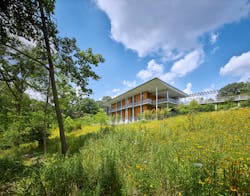A Formula for Stormwater Retention and Reuse
Pittsburgh, Pa.
DESIGN TEAM:
Bohlin Cywinkski Jackson
PHOTO CREDIT:
© Ed Massery, Jeremy Marshall
Some reputations die hard. Granted, Pittsburgh’s legacy as a sooty, steel-making city a century ago was well-earned, but it’s also a thing of the past. In its place is a widespread commitment to environmental stewardship that is slowly but surely earning The ‘Burgh’ a new and better standing in the public eye.
The latest example of this new era is the Frick Environmental Center, the first municipally owned, fee-free public building in the U.S. to earn Living Building certification, a rigorous protocol by the International Living Future Institute.
“The international recognition of the Frick Environmental Center is the perfect reflection of the deeply rooted convictions for sustainability and innovation shared by the city, the Pittsburgh Parks Conservancy, and the entire construction and design team,” says Patricia Culley, AIA, a senior associate at Bohlin Cywinski Jackson’s local office.
Set at the northwest entrance to the city’s 644-acre Frick Park, the 15,750-sq.-ft. center is nestled into a hillside overlooking a natural watershed, providing a human-scale approach in a pleasant park setting, and an active, real-world learning opportunity for visitors, staff and environmental research. “The building’s form enhances the experiential environmental education programs it offers,” says Culley.
One of the more intriguing—and synergetic—aspects of the Living Building protocol was biophilic design, which Culley and her team achieved through the muted tones of the natural materials palette and its four-acre master plan honoring the surrounding parkland. “The center nurtures exploration of and connection with the natural world,” she says.
Funded by donations, the center also needed to be smart with its layout. The floor plan features adaptable, appropriately sized spaces, including two small classrooms that can be combined into one large room for various public and private functions—something the outdoor amphitheater also accommodates when the weather cooperates.
Stormwater Retention and Reuse
The center manages stormwater in both technical and celebratory ways—a formula that is highly effective, efficient, beautiful and engaging. A custom rainwater harvesting system enables the center to collect, retain, and filter the nearly 42 in. of annual rainfall in Pittsburgh at a volume that would easily offset the facility’s potable and non-potable water use.
Maintaining an existing natural sub-drainage divide, stormwater management through the site preserves and restores natural ecological flows, while removing 80% of harmful total suspended solids (TSS) from runoffs—an especially important metric in an area that endures non-point source pollution and combined sewer overflows.
Stormwater that falls north of an allée extending across the front of the Center and into the public park replenishes the Fern Hollow watershed, while stormwater to the south replenishes the Nine Mile Run watershed. Replanting the hillside below the building’s southern elevation, and constructing extensive wetlands, lessens flood erosion and further improves the health of the stream.
Rainwater on the north of the site is harvested from the parking lot’s solar canopies into a 15,000-gallon underground cistern for all non-potable water use. In fact, the collection and storage infrastructure is sized to offset demand for all non-potable and city-supplied potable water two times over, from irrigation of the edible garden, to showers, lavatories and water closets—even the fountain outside the main entrance. By design, the center will achieve a net-zero water balance should regulatory authorities in Western Pennsylvania allow harvested rainwater for potable water purposes; as it is, the reclamation system offsets 76% of the center’s total water use.
